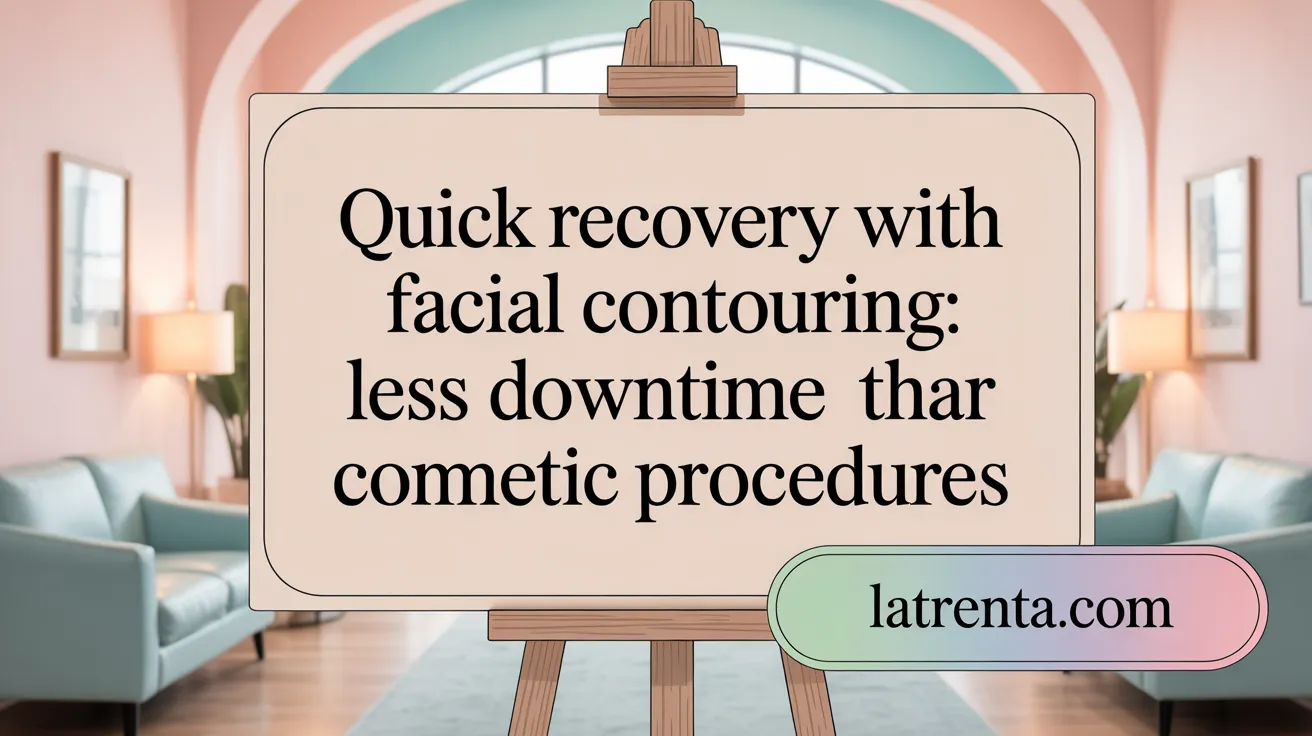Understanding the Recovery Journey After Buccal Fat Removal
Buccal fat removal is a popular cosmetic surgery aimed at sculpting and refining facial contours by removing excess fat from the cheeks. While the procedure itself is minimally invasive, understanding the recovery process is crucial to achieving optimal results safely and comfortably. This guide explores the typical healing timeline, post-operative care, management of side effects, potential complications, and long-term outcomes to help you prepare for the journey ahead.
Typical Recovery Timeline and Healing Stages

What is the typical timeline and stages of healing during buccal fat removal recovery?
The recovery process after buccal fat removal follows a predictable timeline with distinct stages. In the first few days post-surgery, patients usually experience mild to moderate swelling, some bruising, and soreness. This early phase, especially days 1 through 3, involves managing discomfort and swelling with cold compresses and rest.
During days 4 to 7, swelling begins to decrease noticeably, and bruising may become more apparent before gradually fading. Most patients feel comfortable enough to return to work and normal daily activities by days 8 to 10, especially if swelling and bruising lessen significantly.
Between weeks 1 and 2, swelling continues to resolve, with residual puffiness still present. Actual facial contours start becoming more evident as internal swelling diminishes. By the third week, swelling has mostly subsided, external signs of surgery fade, and facial definition improves markedly.
From weeks 4 to 6, most residual swelling is gone, revealing clearer results. However, subtle puffiness can last longer, sometimes up to three months, as internal tissues settle and healing completes.
Final, refined facial contours usually become apparent around three to six months after the procedure. This timing allows swelling to fully resolve and tissues to adjust, revealing the most natural and sustained results.
Overall, patients can expect to see initial improvements within a few weeks, with ongoing refinement over several months. The comprehensive healing timeline ensures that the results after buccal fat removal are both dramatic and long-lasting, provided proper post-operative care is followed.
Post-Operative Care Instructions for Optimal Recovery

Soft diet and hydration
After buccal fat removal, sticking to a soft, nutritious diet is essential to support healing. Patients should avoid hot, spicy, or firm foods during the initial days. Instead, options like smoothies, soups, yogurt, mashed vegetables, and protein shakes are recommended. Staying well-hydrated by drinking plenty of water, herbal teas, or broths helps reduce swelling and promotes tissue repair.
Oral hygiene and incision care
Since the surgery involves small incisions inside the mouth, maintaining oral hygiene is critical. Patients should gently brush teeth and rinse with an alcohol-free mouthwash to prevent infection. Care must be taken to avoid irritation around the surgical site. Proper incision care and avoiding biting or pulling on the cheeks help ensure smooth healing, with dissolvable sutures closing the incisions internally.
Use of cold compresses and head elevation
Applying cold compresses during the first 48 hours significantly reduces swelling and discomfort. Cold packs should be applied to the cheeks for 15-20 minutes every hour or as advised by the surgeon. Keeping the head elevated during sleep and rest minimizes inflammation and facilitates lymphatic drainage, speeding up recovery.
Medication and activity restrictions
Pain is generally mild and manageable with over-the-counter medications or those prescribed by your surgeon. Antibiotics may be recommended to prevent infection. Activities like strenuous exercise, heavy lifting, or vigorous facial movements should be avoided for at least two weeks. Patients are advised to refrain from smoking and alcohol, as these can impair healing. Following these guidelines helps ensure optimal results and minimizes risks of complications.
Managing Common Side Effects: Swelling and Bruising

How can common side effects such as swelling and bruising be managed after buccal fat removal?
Swelling and bruising are common responses following buccal fat removal, usually reaching their peak within the first week and gradually subsiding over the next 2 to 3 weeks. Proper management during this period can help promote comfort and improve healing.
One effective measure is to keep the head elevated as much as possible, even during sleep, to reduce blood flow to the face and minimize swelling. Applying cold compresses to the cheeks in intervals of 10 to 15 minutes during the first few days can help control swelling and lessen bruising. It’s important to avoid strenuous activities and heavy lifting, which can exacerbate swelling.
Medications such as over-the-counter pain relievers like acetaminophen or ibuprofen can be used to manage pain and reduce inflammation, but always follow your surgeon’s instructions on medication use. Some patients find that natural remedies like arnica Montana, taken as directed, may help decrease bruising.
Maintaining a soft diet and staying well-hydrated support the healing process. Gentle facial massages, if approved by your surgeon, can also encourage lymphatic drainage and reduce swelling. Patience remains essential, as these side effects gradually diminish, revealing the refined facial contours achieved by the procedure.
Effective methods to reduce swelling
- Elevate your head, especially when sleeping.
- Use cold compresses consistently during the first 48 hours.
- Follow prescribed medication guidelines.
- Keep physically active but avoid intense exertion.
- Stick to a soft, nutritious diet and stay hydrated.
- Consider gentle facial massages as recommended.
Pain management strategies
Pain is usually mild to moderate and manageable with common over-the-counter medications. Combining medication with cold compresses and rest typically provides the best relief. If pain persists or worsens, contact your healthcare provider promptly.
Importance of patience during recovery
Achieving the final results of buccal fat removal takes time. Swelling and bruising are temporary, and their gradual reduction will reveal the facial definition you desire. Maintaining realistic expectations and following post-op care instructions are essential to ensure a smooth healing process.
Potential Complications and How to Address Them

What are the potential complications following buccal fat removal and how can they be addressed?
Buccal fat removal is generally safe when performed by a qualified surgeon, but like all surgical procedures, it carries some risks. Potential issues include infection, hematoma (a collection of blood outside blood vessels), excessive swelling, pain, facial asymmetry, nerve injury, trismus (difficulty opening the mouth), and damage to salivary ducts.
Though these complications are uncommon, they require prompt attention to prevent long-term effects. Preventive practices involve using precise surgical techniques to minimize tissue trauma and adhering strictly to postoperative care instructions. This includes taking prescribed antibiotics to prevent infection, practicing good oral hygiene, and following a soft diet to avoid irritation.
Recognizing the symptoms early is crucial. Signs such as persistent or increasing pain, unusual swelling, redness, or asymmetry should prompt immediate consultation with the surgeon. Infections are typically managed with antibiotics. Hematomas often require drainage to alleviate pressure and facilitate healing. Nerve injuries, which can cause numbness or tingling, often resolve over time but may need corticosteroids or physical therapy.
Timely medical intervention can significantly improve outcomes. Patients are encouraged to report any concerning symptoms immediately to ensure proper management and reduce the risk of complications. Regular follow-up appointments allow for monitoring healing progress and addressing any issues early, helping to achieve the best possible result from the procedure.
Factors Influencing Healing Speed and Recovery Outcomes

Which factors influence the speed and quality of healing after buccal fat removal?
The healing process after buccal fat removal varies among individuals and is influenced by several factors. A person’s overall health status, including their immune system and presence of any pre-existing conditions, plays a significant role. Healthy individuals who maintain a balanced diet, stay hydrated, and avoid smoking tend to heal faster and more effectively.
The extent of fat removal and the surgical technique used by the surgeon also impact recovery. Less invasive procedures with precise removal typically result in quicker healing and minimal complications.
Adherence to post-operative care instructions is crucial. Proper practices such as keeping the head elevated, applying cold compresses to reduce swelling, and maintaining a soft-food diet help facilitate recovery. Ignoring these guidelines or engaging in strenuous activities prematurely can cause delays and increase the risk of complications.
When buccal fat removal is combined with other facial procedures, the overall results can be more harmonious. However, combining surgeries often extends the healing timeline, as the body needs additional time to recover from multiple interventions.
Complications such as infection, excessive swelling, bruising, or nerve injury can hinder healing and may require additional treatment. Routine follow-ups allow surgeons to monitor progress and address any issues promptly.
Ultimately, long-term results depend on a combination of surgical skill, diligent aftercare, and a healthy lifestyle. Patients who follow their surgeon’s advice and maintain good habits are more likely to experience smooth healing and achieve the desired facial contours.
Comparing Recovery: Buccal Fat Removal Versus Other Facial Procedures

How does the recovery from buccal fat removal differ from recovery after other facial procedures?
Buccal fat removal is known for its relatively quick and straightforward healing process, especially when compared to more invasive facial surgeries such as facelifts, rhinoplasty, or extensive liposuction. One reason for this is that the procedure involves small internal incisions inside the mouth, so there are no external scars and minimal external trauma.
In the initial days following surgery, patients typically experience mild swelling, some bruising, and minor discomfort. Swelling is most noticeable in the first 1-2 weeks but usually subsides faster than with other procedures. Most patients find they can return to work and normal daily activities within three to seven days.
A significant difference in post-op care is the necessity of maintaining excellent oral hygiene because the incisions are inside the mouth. Careful attention to mouth cleaning and avoiding actions like puffing cheeks or using straws helps prevent complications.
In contrast, procedures like facelifts involve external incisions with longer healing times and more visible scars. Recovery from such surgeries often entails weeks of swelling, bruising, and activity restrictions.
Another aspect is that buccal fat removal results are permanent as fat pads are excised, but the healing process remains moderate and well-tolerated. Conversely, non-surgical options like injectables or skin tightening treatments provide temporary improvements with minimal downtime.
Overall, the moderate recovery period, minimal external impact, and internal incision make buccal fat removal an appealing choice for those seeking facial contour enhancement with less disruption and faster healing.
Final Thoughts on Buccal Fat Removal Recovery
Recovering from buccal fat removal involves understanding the natural progression of healing, following diligent postoperative care, and managing common side effects with patience and proper techniques. While minor swelling and bruising are to be expected, most patients can return to daily life within a week, with the full refined facial contour emerging over several months. Being informed about potential complications and factors influencing recovery ensures safety and satisfaction with long-term outcomes. Compared to other facial surgeries, buccal fat removal stands out for its minimal invasiveness and quicker recovery, making it a favorable option for those seeking natural, lasting facial definition.
References
- Detailed Guide on Healing After Buccal Fat Removal
- Buccal Fat Removal: What It Is, Recovery & Before & After
- 7-Day Buccal Fat Removal Recovery Timeline and Insights
- Buccal Fat Removal Recovery: What to Expect Day by Day
- What Is Recovery Like After Buccal Fat Removal? - Dr. Ali Sajjadian
- Buccal Fat Removal Recovery Time - Memorial Plastic Surgery
- Buccal Fat Removal 10 Years Later: Does The Recovery Hold Up?
